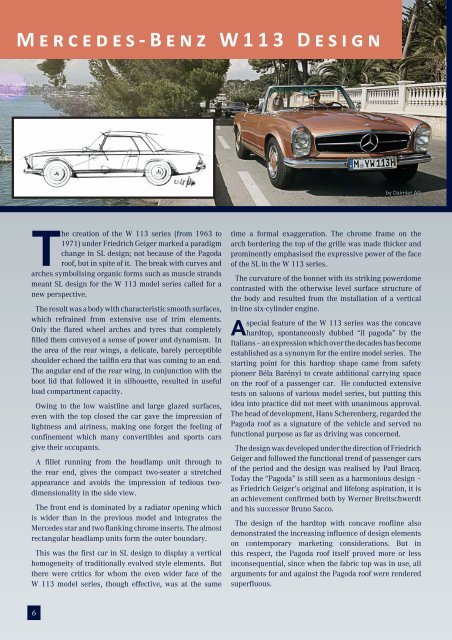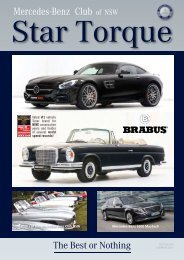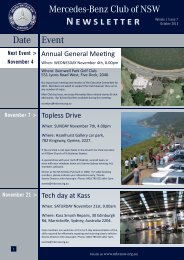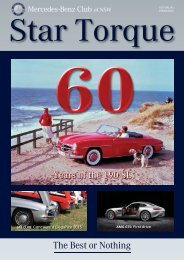Star Torque Issue 244 Winter 2016
Create successful ePaper yourself
Turn your PDF publications into a flip-book with our unique Google optimized e-Paper software.
M -B W113 D<br />
by Daimler AG<br />
The creation of the W 113 series (from 1963 to<br />
1971) under Friedrich Geiger marked a paradigm<br />
change in SL design; not because of the Pagoda<br />
roof, but in spite of it. The break with curves and<br />
arches symbolising organic forms such as muscle strands<br />
meant SL design for the W 113 model series called for a<br />
new perspective.<br />
The result was a body with characteristic smooth surfaces,<br />
which refrained from extensive use of trim elements.<br />
Only the flared wheel arches and tyres that completely<br />
filled them conveyed a sense of power and dynamism. In<br />
the area of the rear wings, a delicate, barely perceptible<br />
shoulder echoed the tailfin era that was coming to an end.<br />
The angular end of the rear wing, in conjunction with the<br />
boot lid that followed it in silhouette, resulted in useful<br />
load compartment capacity.<br />
Owing to the low waistline and large glazed surfaces,<br />
even with the top closed the car gave the impression of<br />
lightness and airiness, making one forget the feeling of<br />
confinement which many convertibles and sports cars<br />
give their occupants.<br />
A fillet running from the headlamp unit through to<br />
the rear end, gives the compact two-seater a stretched<br />
appearance and avoids the impression of tedious twodimensionality<br />
in the side view.<br />
The front end is dominated by a radiator opening which<br />
is wider than in the previous model and integrates the<br />
Mercedes star and two flanking chrome inserts. The almost<br />
rectangular headlamp units form the outer boundary.<br />
This was the first car in SL design to display a vertical<br />
homogeneity of traditionally evolved style elements. But<br />
there were critics for whom the even wider face of the<br />
W 113 model series, though effective, was at the same<br />
time a formal exaggeration. The chrome frame on the<br />
arch bordering the top of the grille was made thicker and<br />
prominently emphasised the expressive power of the face<br />
of the SL in the W 113 series.<br />
The curvature of the bonnet with its striking powerdome<br />
contrasted with the otherwise level surface structure of<br />
the body and resulted from the installation of a vertical<br />
in-line six-cylinder engine.<br />
special feature of the W 113 series was the concave<br />
A hardtop, spontaneously dubbed “il pagoda” by the<br />
Italians – an expression which over the decades has become<br />
established as a synonym for the entire model series. The<br />
starting point for this hardtop shape came from safety<br />
pioneer Béla Barényi to create additional carrying space<br />
on the roof of a passenger car. He conducted extensive<br />
tests on saloons of various model series, but putting this<br />
idea into practice did not meet with unanimous approval.<br />
The head of development, Hans Scherenberg, regarded the<br />
Pagoda roof as a signature of the vehicle and served no<br />
functional purpose as far as driving was concerned.<br />
The design was developed under the direction of Friedrich<br />
Geiger and followed the functional trend of passenger cars<br />
of the period and the design was realised by Paul Bracq.<br />
Today the “Pagoda” is still seen as a harmonious design –<br />
as Friedrich Geiger’s original and lifelong aspiration, it is<br />
an achievement confirmed both by Werner Breitschwerdt<br />
and his successor Bruno Sacco.<br />
The design of the hardtop with concave roofline also<br />
demonstrated the increasing influence of design elements<br />
on contemporary marketing considerations. But in<br />
this respect, the Pagoda roof itself proved more or less<br />
inconsequential, since when the fabric top was in use, all<br />
arguments for and against the Pagoda roof were rendered<br />
superfluous.<br />
6







